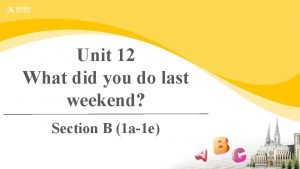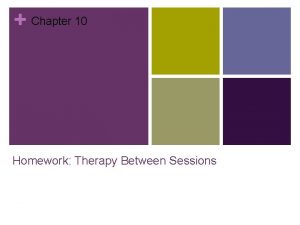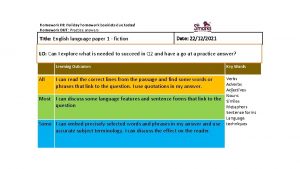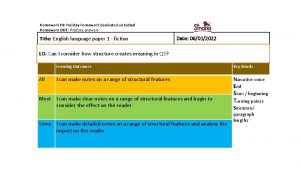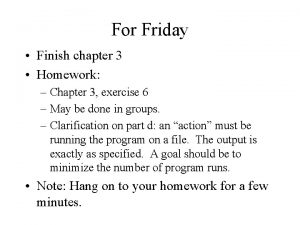For Monday Finish chapter 14 Homework Chapter 13





























- Slides: 29

For Monday • Finish chapter 14 • Homework: – Chapter 13, exercises 8, 15

Program 3

Bayesian Reasoning with Independence (“Naïve” Bayes) • If we assume that each piece of evidence (symptom) is independent given the diagnosis (conditional independence), then given evidence e as a sequence {e 1, e 2, …, ed} of observations, P(e | di) is the product of the probabilities of the observations given di. • The conditional probability of each individual symptom for each possible diagnosis can then be computed from a set of data or estimated by the expert. • However, symptoms are usually not independent and frequently correlate, in which case the assumptions of this simple model are violated and it is not guaranteed to give reasonable results.

Bayes Independence Example • Imagine there are diagnoses ALLERGY, COLD, and WELL and symptoms SNEEZE, COUGH, and FEVER Prob P(d) P(sneeze|d) P(cough | d) Well 0. 9 0. 1 Cold 0. 05 0. 9 0. 8 Allergy 0. 05 0. 9 0. 7 P(fever | d) 0. 01 0. 7 0. 4

• If symptoms sneeze & cough & no fever: P(well | e) = (0. 9)(0. 1)(0. 99)/P(e) = 0. 0089/P(e) P(cold | e) = (. 05)(0. 9)(0. 8)(0. 3)/P(e) = 0. 01/P(e) P(allergy | e) = (. 05)(0. 9)(0. 7)(0. 6)/P(e) = 0. 019/P(e) • Diagnosis: allergy P(e) =. 0089 +. 019 =. 0379 P(well | e) =. 23 P(cold | e) =. 26 P(allergy | e) =. 50

Problems with Probabilistic Reasoning • If no assumptions of independence are made, then an exponential number of parameters is needed for sound probabilistic reasoning. • There is almost never enough data or patience to reliably estimate so many very specific parameters. • If a blanket assumption of conditional independence is made, efficient probabilistic reasoning is possible, but such a strong assumption is rarely warranted.

Practical Naïve Bayes • We’re going to assume independence, so what numbers do we need? • Where do the numbers come from?

Bayesian Networks • Bayesian networks (belief network, probabilistic network, causal network) use a directed acyclic graph (DAG) to specify the direct (causal) dependencies between variables and thereby allow for limited assumptions of independence. • The number of parameters need for a Bayesian network are generally much less compared to making no independence assumptions.



More on CPTs • Probability of false is not given since rows must sum to 1. • Requires 10 parameters rather than 25 =32 (actually only 31 since all 32 values must sum to 1) • Therefore, the number of probabilities needed for a node is exponential in the number of parents (the fan in).


Noisy Or Nodes • To avoid specifying the complete CPT, special nodes that make assumptions about the style of interaction can be used. • A noisy or node assumes that the parents areindependent causes that are noisy, i. e. there is some probability that they will not cause the effect. • The noise parameter for each cause indicates the probability it will not cause the effect. • Probability that the effect is not present is the product of the noise parameters of all the parent nodes that are true (since independence is assumed). P(Fever|Cold) =0. 4, P(Fever|Flu) =0. 8, P(Fever| Malaria)=0. 9 P(Fever | Cold Ù Flu Ù ¬Malaria) = 1 0. 6 * 0. 2 = 0. 88 • Number of parameters needed is linear in fan in rather than exponential.

Independencies • If removing a subset of nodes S from the network renders nodes Xi and Xj disconnected, then Xi and Xj are independent given S, i. e. P(Xi | Xj , S) = P(Xi | S) • However, this is too strict a criteria for conditional independence since two nodes will still be considered independent if there simply exists some variable that depends on both. (i. e. Burglary and Earthquake should be considered independent since the both cause Alarm)

• Unless we know something about a common effect of two “independent causes” or a descendent of a common effect, then they can be considered independent. • For example, if we know nothing else, Earthquake and Burglary are independent. • However, if we have information about a common effect (or descendent thereof) then the two “independent” causes become probabilistically linked since evidence for one cause can “explain away” the other. • If we know the alarm went off, then it makes earthquake and burglary dependent since evidence for earthquake decreases belief in burglary and vice versa.

Types of Connections • Given a triplet of variables x, y, z where x is connected to z via y, there are 3 possible connection types: – tail to tail: x¬ y ® z – head to tail: x¬ y ¬ z, or x ® y ® z – head to head: x® y ¬ z • For tail to tail and head to tail connections, x and z are independent given y. • For head to head connections, x and z are “marginally independent” but may become dependent given the value of y or one of its descendents (through “explaining away”).

Separation • A subset of variables S is said to separate X from Y if all (undirected) paths between X and Y are separated by S. • A path P is separated by a subset of variables S if at least one pair of successive links along P is blocked by S. • Two links meeting head to tail or tail to tail at a node Z are blocked by S if Z is in S. • Two links meeting head to head at a node Z are blocked by S if neither Z nor any of its descendants are in S.


Probabilistic Inference • Given known values for some evidence variables, we want to determine the posterior probability of of some query variables. • Example: Given that John calls, what is the probability that there is a Burglary? • John calls 90% of the time there is a burglary and the alarm detects 94% of burglaries, so people generally think it should be fairly high (80 90%). But this ignores theprior probability of John calling. John also calls 5% of the time when there is no alarm. So over the course of 1, 000 days we expect one burglary and John will probably call. But John will also call with a false report 50 times during 1, 000 days on average. So the call is about 50 times more likely to be a false report • P(Burglary | John. Calls) ~ 0. 02. • Actual probability is 0. 016 since the alarm is not perfect (an earthquake could have set it off or it could have just went off on its own). Of course even if there was no alarm and John called incorrectly, there could have been an undetected burglary anyway, but this is very unlikely.

Types of Inference • Diagnostic (evidential, abductive): From effect to cause. P(Burglary | John. Calls) = 0. 016 P(Burglary | John. Calls Ù Mary. Calls) = 0. 29 P(Alarm | John. Calls Ù Mary. Calls) = 0. 76 P(Earthquake | John. Calls Ù Mary. Calls) = 0. 18 • Causal (predictive): From cause to effect P(John. Calls | Burglary) = 0. 86 P(Mary. Calls | Burglary) = 0. 67

More Types of Inference • Intercausal (explaining away): Between causes of a common effect. P(Burglary | Alarm) = 0. 376 P(Burglary | Alarm Ù Earthquake) = 0. 003 • Mixed: Two or more of the above combined (diagnostic and causal) P(Alarm | John. Calls Ù ¬Earthquake) = 0. 03 (diagnostic and intercausal) P(Burglary | John. Calls Ù ¬Earthquake) = 0. 017


Inference Algorithms • Most inference algorithms for Bayes nets are not goal directed and calculate posterior probabilities for all other variables. • In general, the problem of Bayes net inference is NP hard (exponential in the size of the graph).

Polytree Inference • For singly connected networks or polytrees, in which there are no undirected loops (there is at most one undirected path between any two nodes), polynomial (linear) time algorithms are known. • Details of inference algorithms are somewhat mathematically complex, but algorithms for polytrees are structurally quite simple and employ simple propagation of values through the graph.

Belief Propagation • Belief propogation and updating involves transmitting two types of messages between neighboring nodes: – l messages are sent from children to parents and involve the strength of evidential support for a node. – p messages are sent from parents to children and involve the strength of causal support.


Propagation Details • Each node B acts as a simple processor which maintains a vector l(B) for the total evidential support for each value of the corresponding variable and an analagous vector p(B) for the total causal support. • The belief vector BEL(B) for a node, which maintains the probability for each value, is calculated as the normalized product: BEL(B) = al(B)p(B)

Propogation Details (cont. ) • Computation at each node involve l and p message vectors sent between nodes and consists of simple matrix calculations using the CPT to update belief (the l and p node vectors) for each node based on new evidence. • Assumes CPT for each node is a matrix (M) with a column for each value of the variable and a row for each conditioning case (all rows must sum to 1).

 How did you finish your homework
How did you finish your homework Homework for monday
Homework for monday Simplify √150
Simplify √150 What did your last weekend look like
What did your last weekend look like Homework oh homework
Homework oh homework Homework oh homework i hate you you stink
Homework oh homework i hate you you stink Jack prelutsky homework oh homework
Jack prelutsky homework oh homework Homework oh homework jack prelutsky
Homework oh homework jack prelutsky Homework oh homework i hate you you stink
Homework oh homework i hate you you stink Literal and figurative language
Literal and figurative language Fspos vägledning för kontinuitetshantering
Fspos vägledning för kontinuitetshantering Typiska novell drag
Typiska novell drag Nationell inriktning för artificiell intelligens
Nationell inriktning för artificiell intelligens Ekologiskt fotavtryck
Ekologiskt fotavtryck Shingelfrisyren
Shingelfrisyren En lathund för arbete med kontinuitetshantering
En lathund för arbete med kontinuitetshantering Särskild löneskatt för pensionskostnader
Särskild löneskatt för pensionskostnader Personlig tidbok för yrkesförare
Personlig tidbok för yrkesförare A gastrica
A gastrica Vad är densitet
Vad är densitet Datorkunskap för nybörjare
Datorkunskap för nybörjare Boverket ka
Boverket ka Mall för debattartikel
Mall för debattartikel Autokratiskt ledarskap
Autokratiskt ledarskap Nyckelkompetenser för livslångt lärande
Nyckelkompetenser för livslångt lärande Påbyggnader för flakfordon
Påbyggnader för flakfordon Formel för lufttryck
Formel för lufttryck Svenskt ramverk för digital samverkan
Svenskt ramverk för digital samverkan Urban torhamn
Urban torhamn Presentera för publik crossboss
Presentera för publik crossboss



